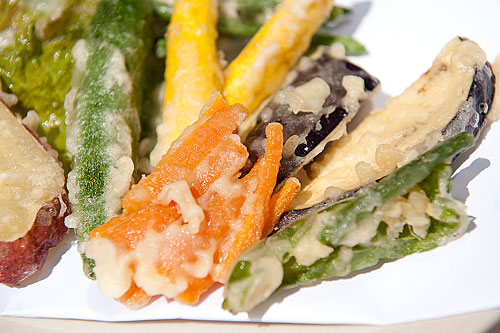
I've never really been good at making tempura, the quintessential Japanese deep fried dish. My mother's tempura has always been terrific - crispy, light, and not greasy at all. So, taking advantage of her extended vacation here this year, I drilled her properly on how she makes tempura.
Her method does not rely on special tempura flour (cheap in Japan but expensive or hard to get a hold of elsewhere), or other recently touted additions like vodka or other high-alcohol liquor, so anyone should be able to do it. Just follow the key points listed below.
Filed under:
japanese vegetables vegetarian washoku
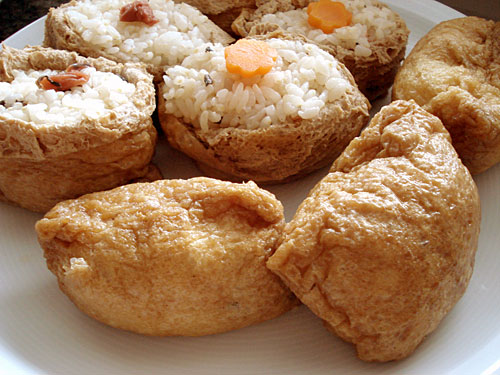
Four years ago I posted a very basic recipe for inarizushi, homely sushi that is stuffed into a fried tofu skin or aburaage. It's been one of the most popular articles here on Just Hungry ever since. That only gave instructions for stuffing pre-made (canned or vacuum packed) skins, so I thought I'd update it with instructions for making your own inarizushi skins from scratch. These instructions will be particularly useful to vegetarians and vegans, since most if not all premade skins are cooked in a fish-based traditional dashi stock. And, for all of you who have had problems making Eggs in Treasure Bags with those small, thin canned skins: You'll find that making the eggs from your own, sturdy skins is so much easier.
Filed under:
japanese vegetarian sushi favorites vegan washoku
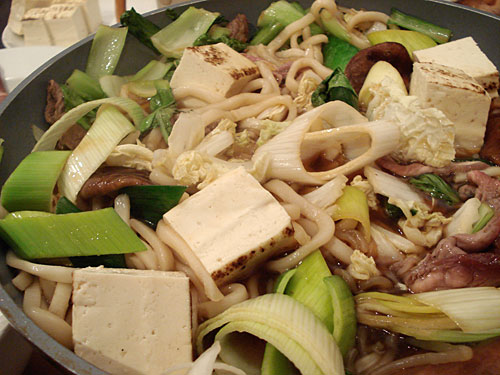
Sukiyaki (すき焼き)is a Japanese word that is widely known outside of Japan, but very few people have actually had the real thing unless they've been invited to a Japanese person's home for dinner - or gone to a traditional inn or ryoutei (high end traditional Japanese restaurant) where it is cooked for you at the table. This is because, like tori nabe, this is really another nabe that is cooked at the table, at home, rather than eaten at a restaurant. You may encounter 'sukiyaki' on some restaurant menus, but if it's been cooked in advance in the kitchen, it really isn't sukiyaki. (I'm not sure why there are dedicated shabu-shabu restaurants but no sukiyaki restaurants, but I think it's because sukiyaki is so strongly associated with home cooking.)
Unlike tori nabe, sukiyaki is not inexpensive, since you need top grade steak-quality meat. If you have access to a Japanese grocery store or a butcher that is familiar with the 'sukiyaki' cut, you can buy ready-cut meat there. (In New York, I used to get sukiyaki meat from Schaller and Weber on the Upper East Side). If you can't get sukiyaki meat, get a piece of sirloin with a good amount of marbling and a thick piece of fat attached. Allow for about 100 grams / 3 1/2 ounces of meat per person. You do not need to use wagyuu or Kobe beef - that would be overkill. In Japan, sukiyaki is the quintessential gochisou (御馳走) - feast or treat, because good beef is the most expensive kind of meat. It's what you have for a special occasion, or just after payday.
Sukiyaki can be enjoyed at any time of the year, but any kind of nabe seems to be best suited to the winter, when the family can gather around the dining table helping themselves from a fragant, steaming pan of food.
There are two basic methods of making sukiyaki: Kanto, or Tokyo-area style, and Kansai, or Kyoto/Osaka area style. Since I'm from the Tokyo area I'll show you how to do the Tokyo style, with a recipe for the Kyoto method below.
Filed under:
japanese party food winter favorites beef washoku nabe

Nabe (鍋, pronounced NA-beh) is the Japanese word for a pot or pan. But it also means a one-pot dish where several ingredients are cooked together in a broth. While nabe can be cooked in the regular way on the stovetop, the most popular kind of nabe are cooked at the table on a portable burner. The quintessential image of a Japanese happy family is one that gathered around the dining table eating a nabe. (Nabe cooked at the table is also called yosenabe (寄せ鍋), which just means a nabe where the ingredients are gathered together (寄せる、yoseru).
Because a nabe is piping hot, it's a great winter meal, with very little preparation.
A lot of Japanese nabe recipes call for ingredients that are only widely available in Japan, but this is a recipe for a nabe that you can recreate wherever you are. It uses chicken and a lot of vegetables, so it's very healthy and frugal - perfect recession cooking! The only special equipment you need is a tabletop cooker of come kind, that can sustain a boiling heat. See more about tabletop cookers in the Notes at bottom.
Filed under:
japanese lighter party food winter quickcook chicken washoku nabe
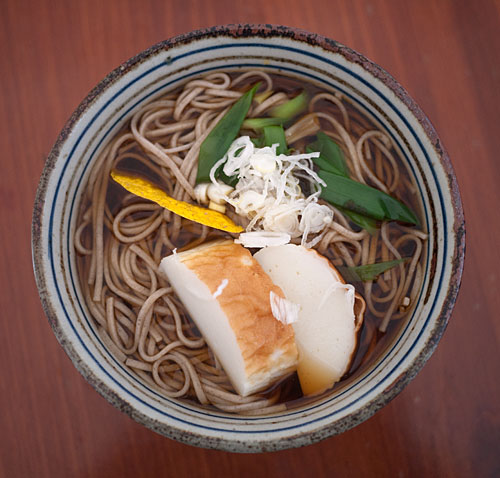
Revised and updated: This recipe for Toshikoshi Soba, or Year-End Soba, traditionally eaten in Japan on New Year's Eve, is one of the earliest recipes posted on Just Hungry. I've expanded the directions so that you can use various methods for making the soup. Originally posted December 30, 2003.
Filed under:
japanese noodles favorites new year soba washoku
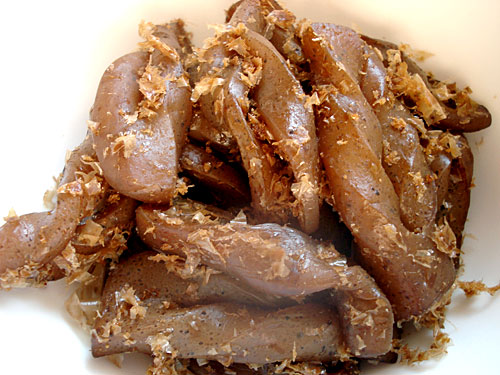
I have talked about konnyaku before, the almost zero calorie, rubbery-jellylike food that makes me really wonder at the ingenuity of people of the past. Why would they think that an almost flavorless, almost nutrient free substance would be edible?
Well, konnyaku is not about its innate flavor - it's all about texture. And since it realy has so little calories, it's a great addition to meals for the dieter, giving a feeling of fullness.
Here are a couple of easy and traditionally Japanese side dishes uses konnyaku. Konnyaku no tosani is konnyaku that is cooked in a flavorful liquid and tossed with plenty of katsuobushi (bonito flakes). __Konnyaku kinpira_ is konnyaku sautéed with sesame and chili pepper.
I tend to make konnyaku dishes when I want to really watch the calories, but still have a hearty appetite.
Filed under:
japanese lighter washoku vegetables kinpira
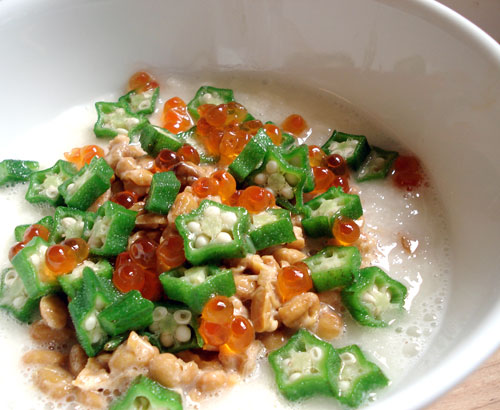
You want slime? I'll give you slime multiplied!
Filed under:
japanese natto offbeat washoku nagaimo slimy
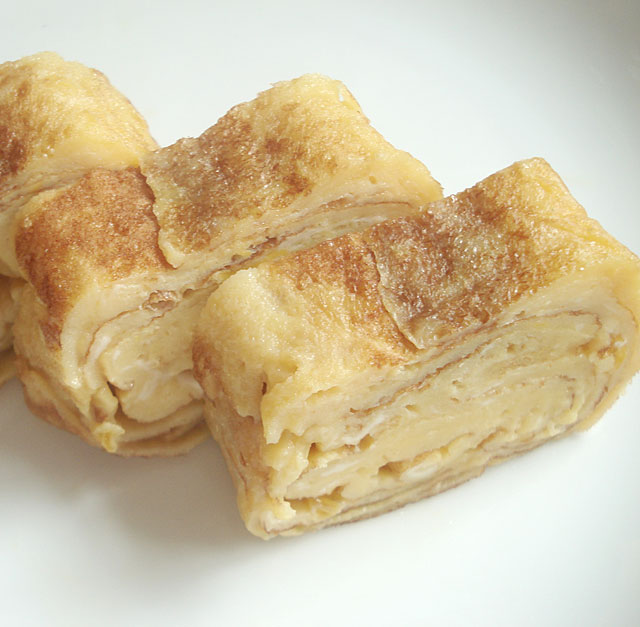
Tamagoyaki is such a integral part of Japanese food that I am rather kicking myself for not having posted a recipe for it before here. The name tamagoyaki means "fried egg", and the alternate name, atsuyaki tamago, means "thick fried egg". (Some books or restaurants erroneously called it just tamago, which just means "egg".) A slightly sweet, moist square-shaped egg concoction, tamagoyaki is a bento box staple, as well as being a popular sushi neta (topping). It's also great as a side dish for any meal.
Filed under:
basics eggs japanese bento washoku
Pages